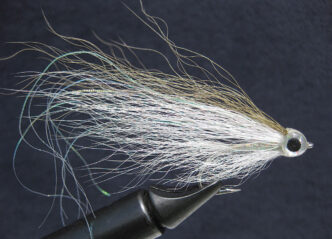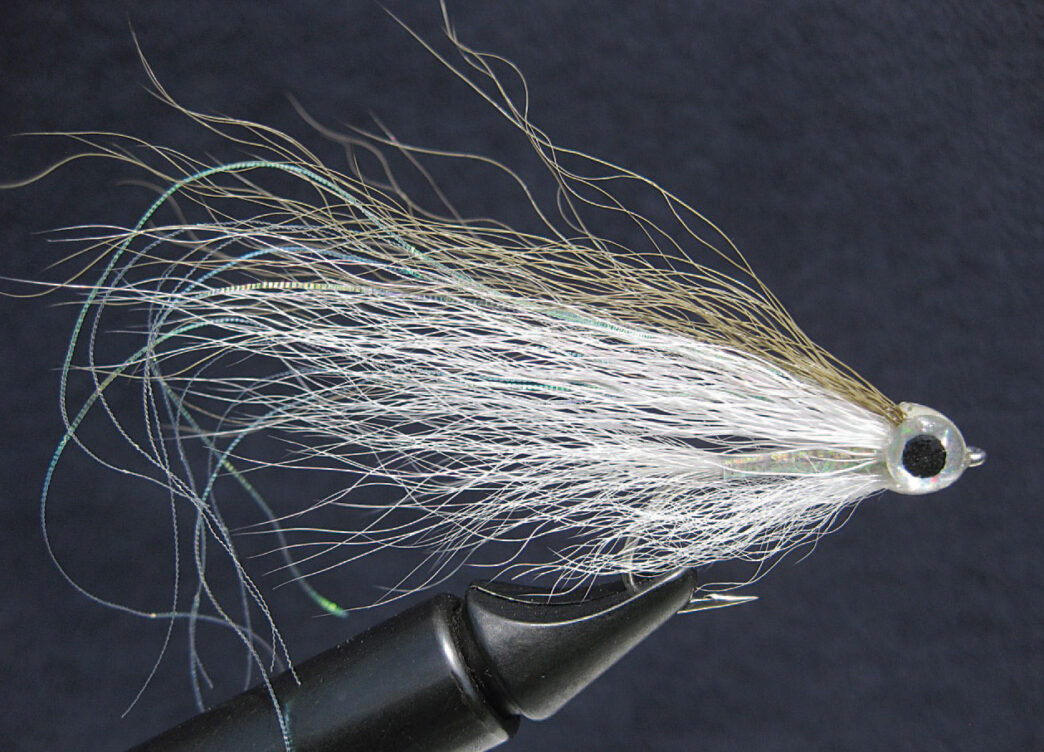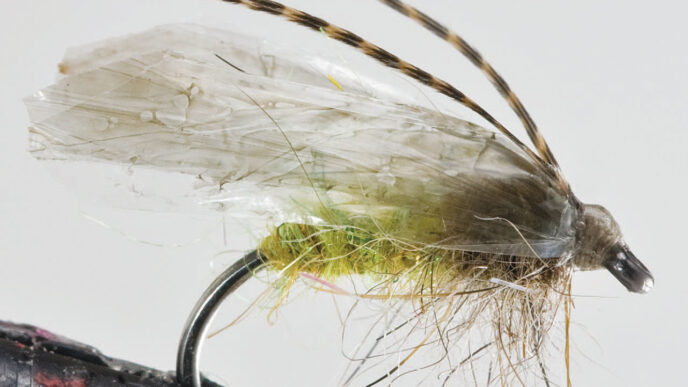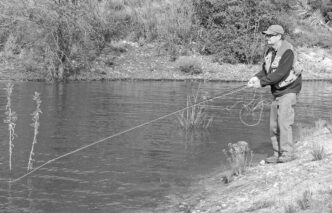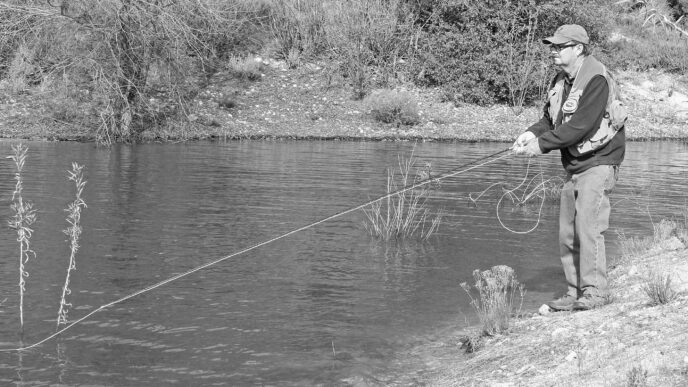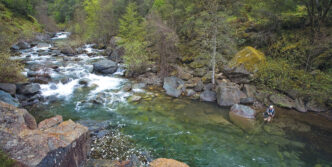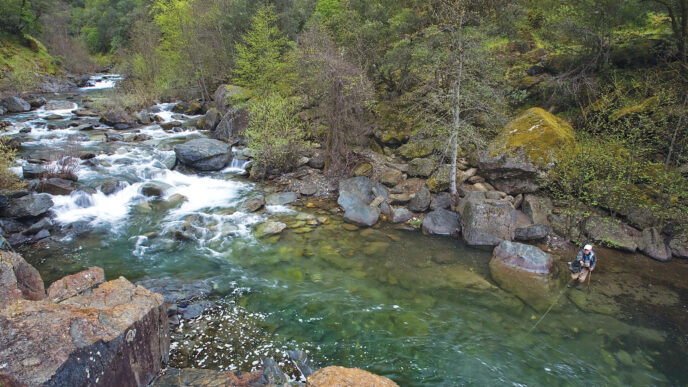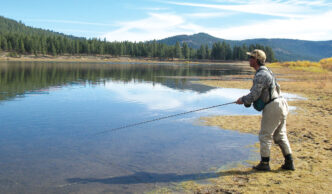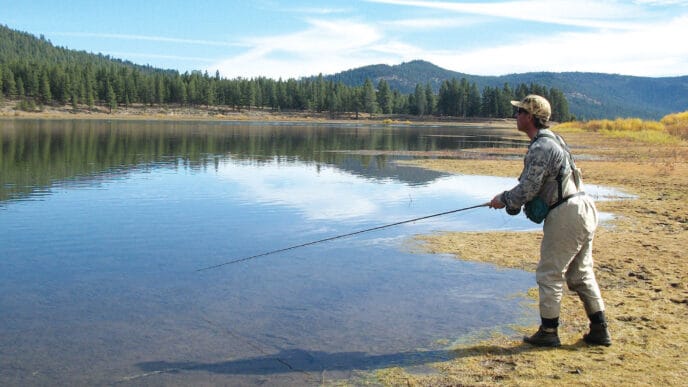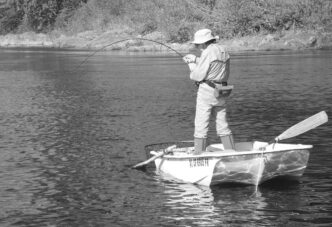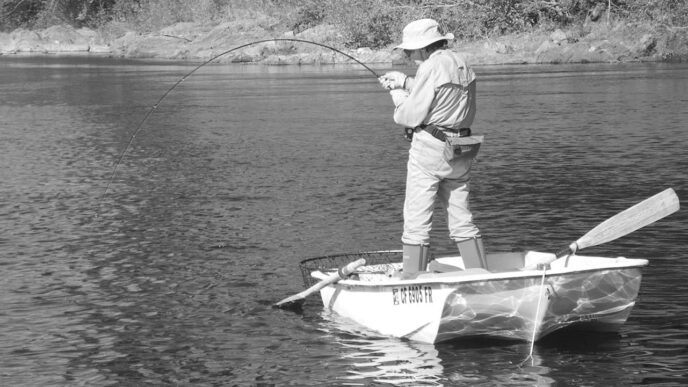As avid fly fishers, we’ve all thought about catching trophy fish. But what is a trophy fish? That judgment, of course, is subjective and relative. However, most anglers would agree that a trout or bass over 10 pounds would fit the bill. To catch a rainbow or brown trout of that size, your chances might be improved by fishing an exotic locale such as Argentina, New Zealand, or Alaska. But here’s the good news: save your airfare, because the best chance of catching a double-digit largemouth bass might be right here in your own backyard.
The Fisheries
Many anglers are aware that the biggest largemouth on record is a 22-pound, 4 ounce monster caught in Georgia in 1932. (This 80-year-old record was tied in 2009 by an angler in Japan.) What many may not know is that the two next-biggest record bass, 22 pounds, 1/2 ounce, and 21 pounds, 12 ounces, were caught in the early 1990s from Castaic Lake, just north of Los Angeles. What is also impressive is that two of the largest bass caught on a fly rod (and released) were from Castaic Lake’s afterbay.
Larry Kurosaki, a full-time fly-fishing guide at Castaic, holds two tippet-class world records: a 14-pound, 8 ounce bass caught on a 12-pound-test tippet in 2007 and a 16-pound, 12 ounce brute caught in 2009 on an 8-pound tippet. (He was using a 6-pound tippet, but the International Game Fish Association tested the breaking strength of the tippet at 6.62 pounds, so the 8-pound tippet class was applied.) These amazing feats were done in the backyard of 16 million people in the greater Los Angeles area. There are many other lakes throughout California that are capable of producing bass of astonishing size. Twenty-one of the top 25 record largemouth bass were caught in California waters. Six of the top 25 bass were from Castaic. Five were from Miramar Lake, near San Diego, and a 25pound, 1-ounce behemoth was caught and released from Dixon Lake, near Escondido, in 2006. (This would-be world-record bass was not eligible for the record because it was foul hooked.) There is no doubt that California is a true world-class bass fishery.
Castaic, just 20 miles from Los Angeles, is arguably the world’s premiere bass lake. It is a reservoir at the terminus of the West Branch California Aqueduct of the State Water Project (completed in 1972), consisting of an upper lake and an afterbay, known as “the lagoon.” The upper lake covers approximately 2,235 acres, is 330 feet deep, and has 29 miles of shoreline. Due to the large size of the reservoir, it is best fished from a motorized boat. Float tubes are prohibited. The lagoon has 197 acres and is 70 feet deep with approximately 3 miles of shoreline. Nonmotorized boats and those with electric trolling motors are permitted on the lagoon, but use of gasoline-powered motors is prohibited on this smaller water. Float tubes are also permitted on the lagoon. Of course, shore fishing is allowed at both the lake and the lagoon, and it can be surprisingly good with a fly rod.
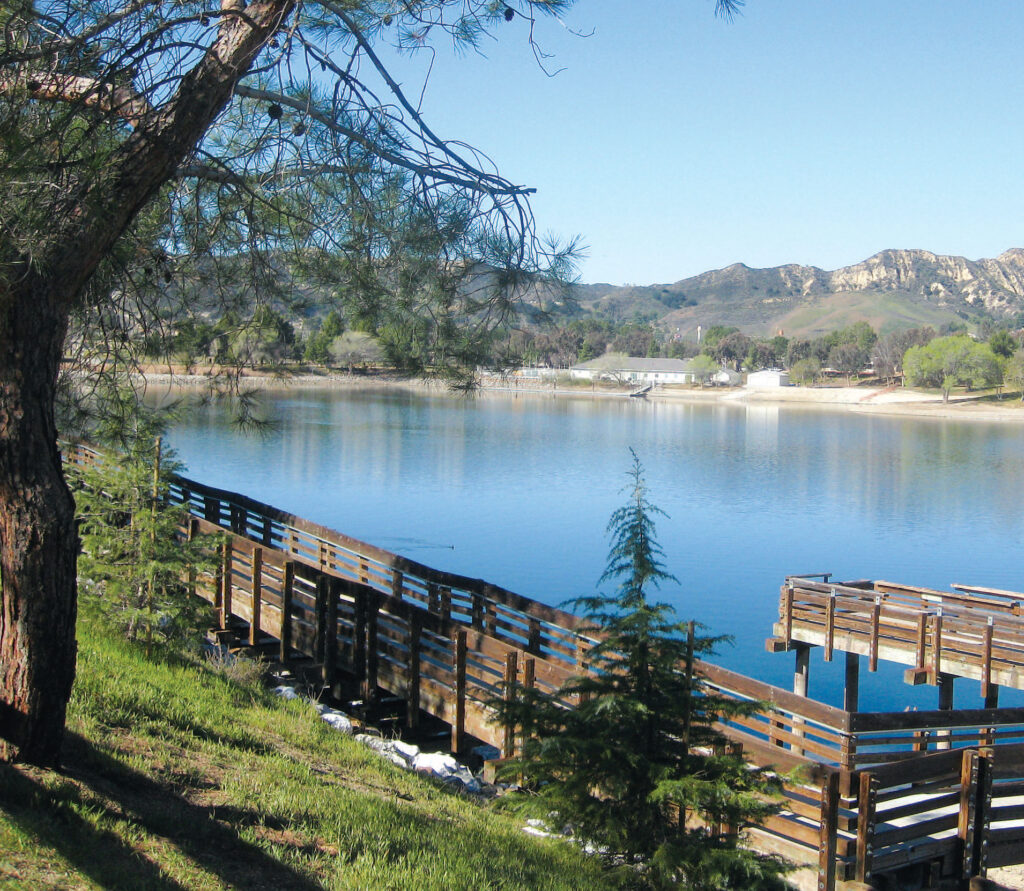
The lake contains stripers, trout, carp, catfish, bluegills, green sunfish, crappies, smallmouth bass, forage fish, and, of course, largemouth bass. The lagoon has a similar assortment of fish, except for stripers. Since 2009, trout are no longer being stocked in the lagoon, for fear they may make their way over the spillway and interbreed with the steelhead in the Santa Clara River system. The number of trout is therefore dwindling in the lagoon.
At one time, it was thought that the next world-record bass would come from the lagoon, because many bass specialists, after an official weighing, would release their ponderous fish into the afterbay, rather than into the lake. This smaller body of water would therefore have a concentration of outsized bass. But with the elimination of trout stocking, the focus is shifting away from the lagoon, because planted trout are seen, in part, as feed for big bass. Therefore, conventional wisdom suggests that fewer stocked trout equals fewer big bass. On the plus side, this shift in attention may relieve some of the fishing pressure on the lagoon.
Big Bass
The California Department of Fish and Wildlife (DFW ) admits that not much is known about the Castaic Lake and lagoon fisheries, but acknowledges that studies are needed. A major study is scheduled for the lake in May 2013. The largemouth bass in Castaic waters, often referred to simply as “black bass,” are assumed to be the Florida-strain subspecies or are assumed to share the genetic makeup of this strain. The Florida-strain bass were first introduced into San Diego reservoirs in 1959 and subsequently into other California lakes. Because of many factors, including California’s mild climate, these fish have thrived, some attaining amazing proportions. According to some fisheries biologists, the Florida-strain bass seem to be more difficult to catch than other types of bass species and consequently have a tendency to live longer. Since fish grow larger with age, Florida-strain bass tend to be outsized.
Why Flies?
We usually think about bass fishing as being the realm of bait casters and spincast anglers. Indeed, they predominate in this fishing niche. Not to take anything away from these guys (it does take skill to make precision casts with conventional gear, and it requires a lot of know-how to be successful), but according to Larry Kurosaki, the big, wise, old bass see an unceasing display of crankbaits, swimbaits, spinnerbaits, and so on in heavily fished waters. They rarely see flies. If some biologists’ opinions are correct that the big Florida-strain bass are wary of lures, then flies may have an edge.
One can argue that you can’t beat fishing live bait. That may be true in many situations, but fishing live bait has limitations. Bass are primarily ambush hunters. They stick to structure and cover, waiting for prey to come by. So you need to bring the lure, fly, or bait to them. That means covering as much water as quickly as possible. You cannot do that as efficiently with a live crayfish or worm as you can with lures or flies. Moreover, when bass are suspended in the water column for thermal reasons, for example at the depth of 20 feet in 40 feet of water, a live crayfish or worm swimming by would be unnatural. While live bait has its place, flies have their place. The reason more big bass are not caught on a fly may just be a function of so few flyrodders pursuing them.
Kurosaki recounted the time that he and a buddy went fly fishing on Lake Casitas, a big bass lake located in Ventura County, during a bass tournament. They were not entered in the competition, but were having a prolific day, while the conventional-tackle bass specialists were being stymied. A couple of bass boats edged up to them as they were hauling in one bass after another. When asked what they were using, he showed them. The other anglers were dumbfounded to see it was a tiny minnow pattern.
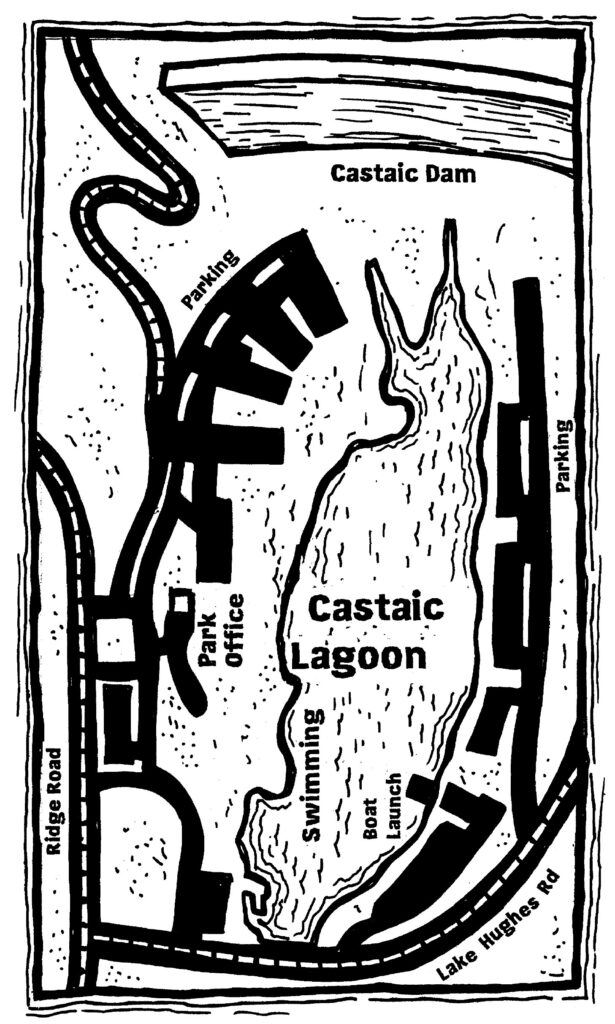
Catching Big Bass
How do you go about catching a world-record bass, or at least a trophy bass, on a fly? Kurosaki, who has fly fished Castaic Lake and its afterbay since 1979 and for many years fished these waters virtually every day (this is not a misprint), has a system for doing this. He uses a 7-weight rod to fling a 15-foot leader and 30-foot fast-sinking shooting head tethered to Amnesia monofilament running line. This setup allows him to throw a fly he calls Larry’s Minnow 120-plus feet. This in itself is amazing, considering the distance and the difficulty of managing nearly a hundred feet of mono running line without it becoming a tangled mess. Kurosaki does not suggest that fly fishers new to shooting heads use this setup initially. It is wiser to start with an integrated shooting head with a small-diameter, coated running line. Ultimately, however, you want to have a line that descends as quickly as possible, because most of your fishing will be subsurface — at a depth of 20 feet or more. This can be best achieved with a slender mono running line. You do not need to cast 100 feet to be successful, but casting 50 feet is the minimum, Kurosaki says, and the farther, the better.
In his books and articles, Denny Rickards, the stillwater trout expert, also stresses the importance of making long casts when retrieving submerged flies in lakes. In an article in California Fly Fisher a few years ago he described a hypothetical situation in which you consistently cast 50 feet, and your fishing buddy casts only 40 feet. Let’s assume that your 10-foot-longer cast is seen by two more trout than your partner’s 10-foot-shorter cast. As Denny says, if you make 15 casts an hour and fish for eight hours, the longer cast will show your fly to 240 more fish! Chances are that some of these fish would be enticed to bite. Now imagine you were to cast 70 feet consistently. “The potential is intriguing, isn’t it?” says Rickards. So imagine casting 120 feet.
One thing this means is that if you want to maximize your chances of catching a lot of fish in still waters, you may want to increase your casting distance by practicing or taking lessons with a casting instructor. If you make this investment in yourself, it will pay dividends on the water. When Larry Kurosaki makes his long casts, he doesn’t cast blindly, just to cover the water. When he’s not casting to fish that are suspended in the water column for thermal reasons, he directs his casts to known submerged structure, whether it is a slight depression or a high spot on the bottom. This structure may be as subtle as a basketball-size rock. If you are not familiar with the bottom structure of a reservoir or lake, a fish finder could help you focus on the potentially productive areas. And if a reservoir is ever drawn down, take that opportunity to walk its shore. Bass-holding structure will be revealed, so you can key on those spots when the water level is back up.
Intimate knowledge of the bottom structure has its rewards. Besides holding the 8-pound and 12-pound tippet-class world records, Kurosaki has achieved some other remarkable results, such as having many days when he caught (and released) over 120 bass. Or there was the day when he caught 5 bass totaling 55 pounds — again, all on a fly rod. And, here’s the kicker: he has caught and released bigger bass than his world-record fish, but there were no witnesses, and there was no camera to document these catches.
Kurosaki generally fishes subsurface, and 80 percent of the time, he uses his Larry’s Minnow, which mimics the forage fish prevalent in the lake and lagoon. This fly is nearly neutral in buoyancy, so during the pause phase of Larry’s very quickstripping retrieve, the fly doesn’t dip or rise unnaturally. Think about it — a real minnow, after darting, stays in place. It doesn’t pause, then sink or rise vertically. This is one reason the fly works so well. Larry makes this fly himself for his own use, but it is also available at the Fishermen’s Spot in Van Nuys.
Although most of the bass at Castaic are taken subsurface, there are times when surface fishing is the ticket. These are exciting times — seeing the water’s surface bulge near your fly, moments before a bucket mouth slashes into it, then tightening the line to have the water explode. To many, dry-fly fishing is the essence of fly fishing and the most fun. This is dry-fly fishing writ large.
Ken Lindsay, of the Fisherman’s Spot fly shop, has been fishing Castaic Lake and the lagoon since the mid-1970s, even longer than Larry Kurosaki. He’s had banner days with top-water action using 6-weight and 7-weight rods to fling frog patterns and deer-hair diving baitfish patterns. A good outing is catching 10 to 15 bass weighing two to four pounds, according to Lindsay.
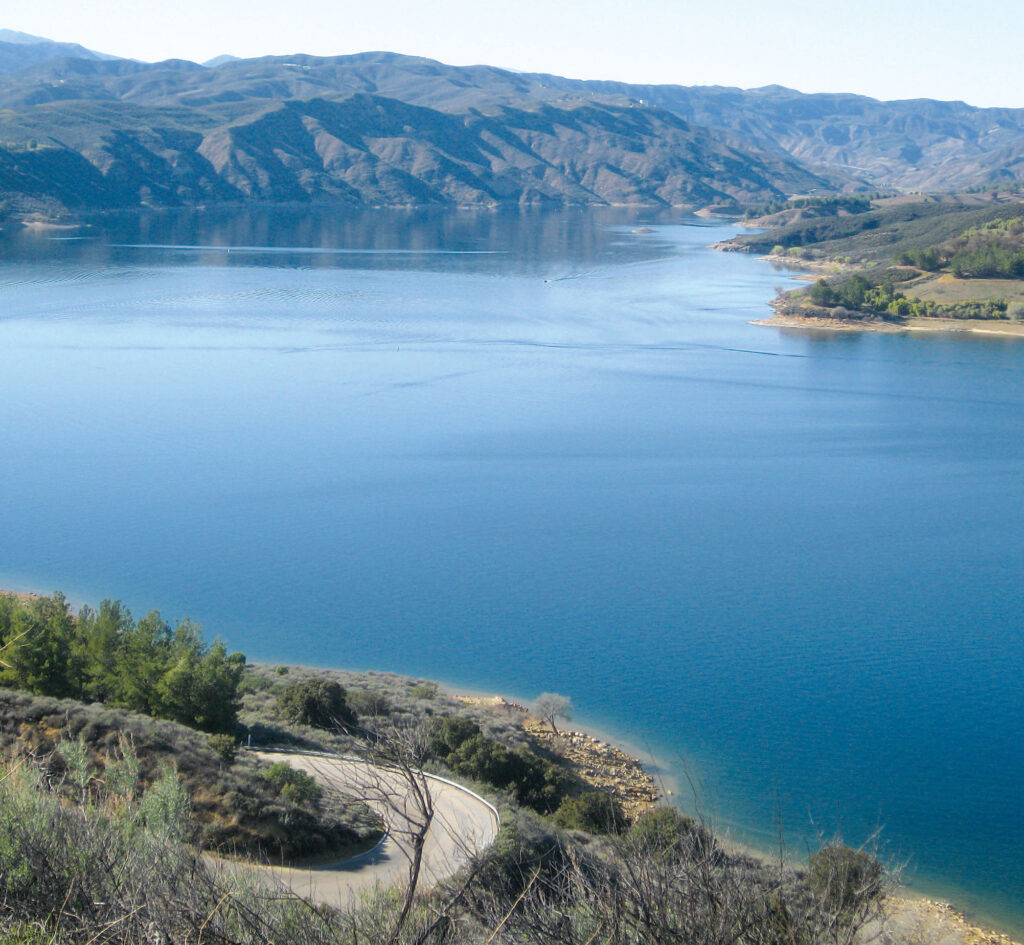
He says one of the best times for surface action at the lake is in the spring, from April to early June, and success is dependent on water temperature. When the water is in the range of 70 to 74 degrees, conditions are nearly ideal. When those conditions occur on the lake, he targets the back of coves, away from boat traffic.
On the lagoon, the best season for surface action is the summer, Lindsay says. The best place is at the shallow north end in the weedy areas, again away from boat traffic.
Another time for top-water action on both the lake and lagoon is in the fall, around October and into November, before a cold snap. The real excitement begins, according to Lindsay, when shad are chased to the surface by marauding predators — bass and stripers on the lake, largemouth bass on the lagoon. Look for diving birds or “nervous” water to locate the bait ball, then simply strip a minnow pattern on the surface at the edge of the ball to mimic a straggler. Or since the bass “tail slap” the schooling fish, let the fly lie motionless in the mix, with a few erratic twitches, thereby mimicking a stunned minnow, then hold on.
For minnow patterns Lindsay likes unweighted versions such as the Gummy Minnow or Larry’s Minnow. For subsurface fishing, he says that Larry’s Minnow is the go-to fly, but Clousers and Deceivers can work well, too. He also likes to bounce an impressionistic crayfish imitation slowly down a submerged rocky slope where bass wait in ambush.
When to Fish
In general, the best time to fish Castaic for big bass is generally from March through June. The fishing picks up again in September through October. The spawn begins around the end of February and extends through June. In the February 2013 issue of California Fly Fisher, Richard Alden Bean’s article “Prelude to the Spawn” discusses the opportunity and techniques for fishing deep for big, fat bass staging for the spawn. This is precisely the time of the year — the prespawn — when Kurosaki nailed the two world-record bass using techniques similar to those described in Bean’s article. According to the DFW’s reservoir biologist, Russell Black, this is the time that shad will also spawn, venturing from deeper water to the shallows to deposit their sticky eggs on rocks and plants. Individual shad are particularly vulnerable then, and that’s why a minnow pattern can be so deadly.
Generally, the best time of the day to catch trophy bass is at first light and one or two hours before dark. Yet Larry Kurosaki caught his two record breakers between 10:00 A.M. and noon. However, he caught them by fishing deep. With most stillwater fishing, the maxim is to fish deep when the sun is high.
In Castaic waters, the bass go deep during both the summer and the winter to seek more comfortable temperatures. Bass can tolerate a wide range of temperatures, but Kurosaki believes the ideal temperature for bass activity is 65 degrees. According to the DFW’s Black, bass will move away from the shallows when water temperatures exceed 81 degrees. To target fish suspended in the water column seeking thermal relief, Larry Kurosaki uses a countdown method before starting his retrieves. That’s another reason why it is good to have a fast-sinking line or shooting head. You don’t want to spend your time on the water waiting for the fly to descend to the proper zone — you want to maximize the time you are fishing in the zone. Again, the longer the cast, the longer your fly will be in the zone.
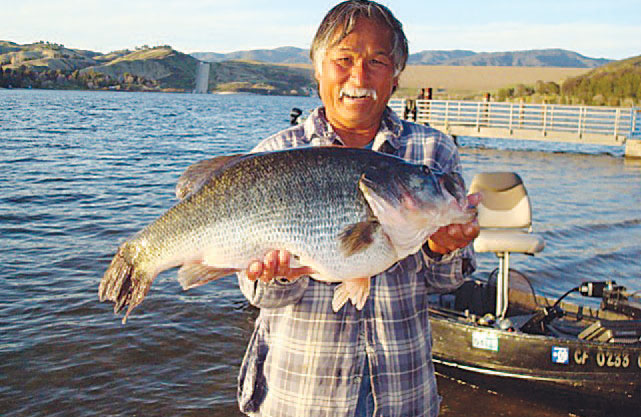
Give It a Try
Most fly fishers pursue trout, but because of the convenient location and the potential to catch gargantuan fish in pleasant surroundings, you may want to try fly rodding for trophy bass on Castaic Lake or its lagoon. Or if you are not in the greater Los Angeles area, try other big-bass lakes throughout the state, such as Clear Lake, Casitas, and Miramar. With practice and time, you, too, may enjoy rewards similar to those of the fly fishers featured in this article. Sometimes, however, nuance is the difference between success and failure. So to expedite your learning process, you may want to go out with a fly-fishing guide. You will then have a realistic chance of catching a true trophy fish — and maybe even a world-record bass in your own backyard.
If You Go . . .
Castaic Lake is a state recreation area administered by the County of Los Angeles and is located about 20 miles north of the Los Angeles city limits. Exit the 5 Freeway at Lake Hughes Road and go east three-quarters of a mile to the lagoon or a couple of miles farther up the hill to the lake. There is a vehicle entry fee of $11 ($5 for seniors on weekdays) and boat launching fees of $13 for motorized boats and $7 for nonmotorized boats, such as float tubes. Note that float tubers are required to have a Coast Guard–approved personal floatation device, as well as a 12-inch-by-12-inch orange square on the back of their tubes for safety. (You may be sharing the water with sailboats.) To prevent the spread of the quagga mussel into the lake and lagoon, all watercraft are inspected prior to launching, so make sure that your vessel is dry and clean. See the Web site at http://castaiclake.com for tips for passing the inspection. Boat rentals are available at the lake. There is camping at the lagoon.
Jerome Buckmelter



